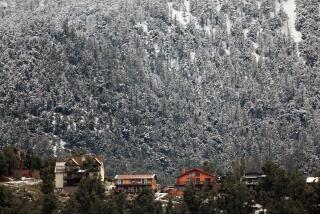Large Carnivores Feeling the Bite of Development
- Share via
BRASOV, Romania — For the fabled wolves and brown bears roaming the dark forests of Transylvania, communism wasn’t all that bad.
Romania’s notorious dictator, Nicolae Ceausescu, who ruled for 25 years before communism collapsed, outlawed bear-hunting for all but himself and his friends.
As a result, when Ceausescu was toppled and executed in 1989, the country’s forests were teeming with bears and other animals. In fact, there were too many, environmentalists say. Shepherds and farmers lost much livestock to wolves and bears pushed out of the forests in search of food.
But experts say the future could hold bad news for the beasts of the East.
They say rapid development, spurred by the prospect of joining the European Union, could carve up one of the continent’s few remaining wildernesses and endanger its animal life.
In a report this year, the World Wide Fund for Nature warned that development threatens the Carpathian mountains that run from Austria through Slovakia, the Czech Republic, Hungary, Poland, Romania and Ukraine.
The bulk of the Carpathians’ 39,000 square miles are in Romania, where the vast, virgin forests of Transylvania are among Europe’s last pristine ecosystems.
The WWF predicts that the rapid spread of highways and modern agriculture will lead to “land degradation and the loss of biodiversity” in the Carpathians. Highways will fragment habitats, and European Union farm policy encourages overproduction, large-scale mechanized farming and use of chemical fertilizers, it says.
All the former communist countries in the Carpathians except Ukraine are expected to join the EU by 2007.
At stake are the large carnivores -- bears, wolves, lynx -- and a slew of other animals, including the chamois and imperial eagle, that dwell in forests of pine, beech, hazelnut and fir.
Decisions made now about construction and conservation will determine whether Romania’s natural treasures will ultimately survive, says George Predoiu, a carnivore specialist at the state Forest Research and Management Institute.
“The bear population isn’t threatened now,” he said. “But it could be in 10 years because of development.
“Our goal is to manage the situation now in order to prevent them from becoming threatened,” added Predoiu, who runs a project that gives farmers free electric fences to protect livestock against attacks by the big meat eaters.
He and other Romanian environmentalists fear that the Carpathians will go the way of Western Europe, where alpine areas have become overdeveloped, and wolves, bears and other species are extinct.
“In France, there are debates as to whether there are four or five bears left in the entire country,” said Ioan Abrudan, a professor of forestry at Transylvania University of Brasov. “In this country, there are more than 5,000.”
There are also about 3,000 gray wolves -- a species exterminated in nearly all Western and Central European countries -- and some 2,000 lynx, making the Romanian Carpathians home to the highest concentration of large carnivores in Europe.
For once, communism gets a little credit.
“I think it was a myth that communism was terrible for the environment,” said Paul Csagoly, a spokesman for the WWF in Budapest, Hungary. “Communism concentrated people and industry, and then you got the smokestacks and chemical spills. This is what the West took photos of. But outside of those concentrated areas, the land was nationalized and left alone.”
With people eager to transform potholed roads into fast highways and to retreat on weekends from dreary communist-era apartments in polluted cities to mountain cottages, pristine areas will not remain so forever.
Already, forests that were nationalized in the 1950s and 1960s are slowly returning to private ownership.
“Before 1989, there were no landowners’ rights,” Predoiu said. “But since the 1990s, it’s again possible to build private homes, and many have been built throughout the Carpathians -- wherever there’s a road and a power line.”
Since 1989, hunting has been fully opened to foreigners, who pay up to $25,000 to kill a bear. Romanians pay much less -- up to about $400.
To meet EU requirements, Romania implemented international agreements in the 1990s that strictly limit the numbers of wild animals that can be culled and exported. For now, legal hunting poses little threat to the long-term survival of Romania’s carnivores.
But this could change.
Predoiu predicts that as rural populations modernize, they will increasingly demand the removal of the bears and wolves that prey on their livestock.
Although lynxes -- so shy that some local people doubt that they even exist -- inflict almost no damage on livestock, hunters oppose protecting them because one lynx can kill 50 to 60 deer a year.
Already, other countries in Eastern Europe are coming under pressure to reduce the number of predators.
In October, Slovenia doubled the number of bears that can be hunted yearly, which could cause that country’s 400 bears to disappear soon, experts say. The government justified its decision by citing the damage that bears cause.
In Romania, hunters insist that they are committed to preserving the number of animals in the forests.
Sitting in his office under a mounted boar’s head, Tudor Daneti, 73, the president of the hunting association in Brasov, describes his support for strict hunting laws and recalls how game managers used to fatten up bears to make them easy prey for the dictator.
“Ceausescu wasn’t a hunter -- he was a killer,” Daneti said. “But no one really thinks about this anymore. We have other problems now.”
More to Read
Sign up for Essential California
The most important California stories and recommendations in your inbox every morning.
You may occasionally receive promotional content from the Los Angeles Times.










